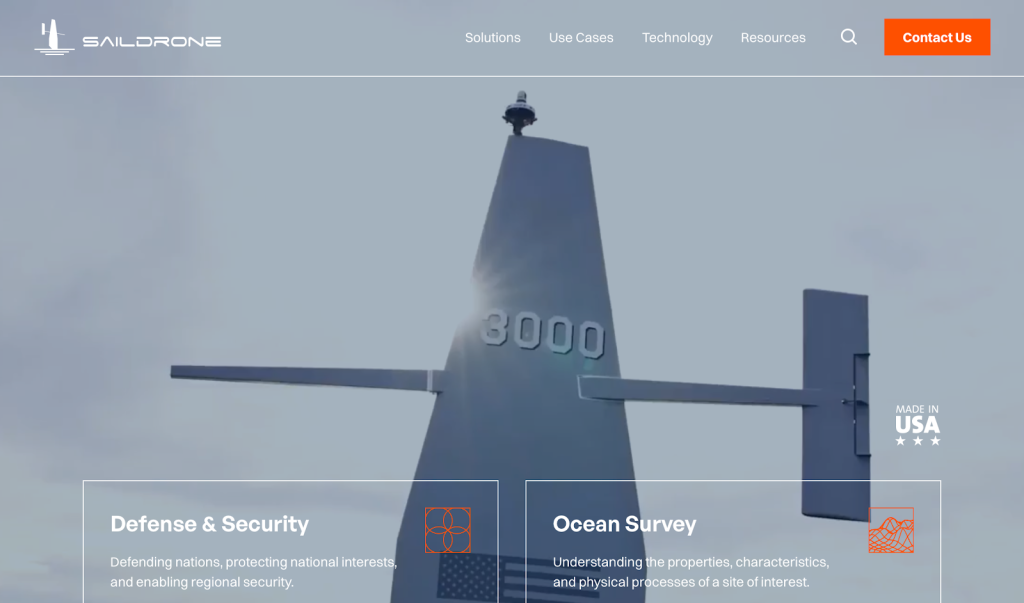Saildrone Secures $60M to Advance Autonomous Ocean Intelligence and Maritime Defense
July 14, 2025
byFenoms Startup Research

Saildrone, a pioneering autonomous ocean data company, has raised $60 million in new funding to expand its fleet of AI-powered unmanned surface vehicles (USVs) and scale operations across defense, climate, and maritime surveillance. The round included participation from top-tier investors including EIFO, Lux Capital, Washington Harbor Partners, Crowley, Academy Securities, Pinegrove, BZH Capital, What If Ventures, and Calm Ventures.
Led by founder and CEO Richard Jenkins, Saildrone is redefining how governments and industries gather data at sea - with real-time intelligence, unmatched endurance, and zero carbon emissions.
Transforming Ocean Intelligence
Saildrone’s technology merges advanced autonomy, machine learning, and durable design to solve one of Earth’s biggest challenges: gathering persistent, high-resolution data in remote and hostile ocean environments. Its wind and solar-powered USVs - roughly the size of a small sailboat - can stay at sea for up to 12 months without refueling or human intervention.
These vehicles serve a wide range of sectors, from climate science and fisheries management to national defense and maritime domain awareness. Whether it’s detecting illegal fishing, tracking ocean carbon flux, or monitoring hostile activity near strategic chokepoints, Saildrone is turning the ocean into a connected, observable ecosystem.
“We’re entering an era where autonomous ocean intelligence is critical to economic security and national resilience,” said Jenkins. “Saildrone is proud to lead the way.”
Why the Ocean Economy Is Heating Up
The total addressable market for ocean intelligence and maritime surveillance is projected to exceed $250 billion by 2030, according to Blue Economy projections by the World Bank and OECD. That includes applications in defense, shipping, environmental compliance, energy exploration, and disaster preparedness.
Climate change and global security threats are accelerating demand for persistent maritime visibility. Meanwhile, traditional monitoring methods - like crewed vessels and satellites - are either too expensive, too slow, or too limited in resolution and endurance.
The ocean covers over 70% of Earth’s surface, yet more than 80% remains unmapped and unobserved in real time, per NOAA. As governments race to protect maritime borders, secure undersea infrastructure, and understand climate change, the demand for continuous, high-fidelity ocean data is exploding.
Saildrone fills this gap with a cost-efficient, carbon-neutral fleet that can operate in swarms, collect multisensor data, and respond to evolving missions.
What makes Saildrone’s model so defensible is its multi-domain utility fused with hardware-software symbiosis. In sectors like climate tech and defense, the key to scale isn’t just automation - it’s vertical integration across data capture, analysis, and delivery. Saildrone doesn’t just build the boats - it owns the data layer, the mission interface, and the analytics platform. Founders building in frontier tech should ask: Are we building a product - or a system of record? In regulated, slow-moving industries, owning the system of record is the shortcut to monopoly power.
Dual Mandate: Climate and Defense
Few startups can operate credibly in both national security and climate science. Saildrone stands out by doing both.
In defense, the company provides maritime situational awareness solutions, offering an agile alternative to costly naval patrols. It supports real-time threat detection, undersea surveillance, and strategic deterrence operations, making it a vital partner for the U.S. Navy and allied forces.
The U.S. Department of Defense’s budget for autonomous systems is expected to exceed $7 billion annually by 2026, reflecting a broader trend toward robotic ISR (Intelligence, Surveillance, and Reconnaissance) tools. With Saildrone’s proven resilience in extreme maritime conditions, its fleet offers military-grade value without the logistical burden of traditional manned assets.
In climate, Saildrone contributes vital data to NOAA, NASA, and leading scientific institutions. It’s the only company to ever sail directly into a Category 4 hurricane and transmit internal storm data in real-time - something even satellites can’t achieve with comparable fidelity.
Its USVs are already deployed across the Arctic, Pacific, and Gulf of Mexico, and are actively involved in CO₂ monitoring, ice sheet observation, and ocean acidification tracking.
Funding Deployment and Future Plans
With the fresh $60 million in capital, Saildrone aims to:
- Expand its global fleet of autonomous USVs
- Enhance its AI-powered mission software, including autonomous navigation and object detection
- Strengthen manufacturing and supply chain capacity to meet defense demand
- Accelerate international expansion, especially in Europe and Asia-Pacific
- Scale data infrastructure and real-time analytics for both government and commercial customers
The company’s infrastructure-first model enables repeatable, subscription-based intelligence for its clients - turning episodic missions into continuous visibility.
About the Investors
- Lux Capital, a repeat backer of deep tech ventures, has supported Saildrone through multiple stages, citing the company’s alignment with global security and sustainability themes.
- EIFO, Denmark’s Export and Investment Fund, adds international strategic weight, likely facilitating EU expansion.
- Crowley, a maritime logistics giant, is also a key partner in integrating Saildrone into existing naval and shipping networks.
- Other investors include Washington Harbor Partners, Academy Securities, Pinegrove, BZH Capital, Calm Ventures, and What If Ventures, forming a diverse syndicate of defense, sustainability, and capital efficiency specialists.
What’s Next for Saildrone
As ocean visibility becomes a strategic priority for both governments and private industries, Saildrone is positioned to lead a category it helped create. Its ability to operate at the intersection of hardware, AI, and sustainability gives it a rare edge in a crowded climate and defense tech landscape.
The company’s long-term roadmap includes expanding its mission types - from environmental enforcement and undersea mapping to autonomous maritime security grids.
Saildrone isn’t just a fleet of smart boats - it’s an intelligence network with global reach, delivering mission-critical insights at the speed of need.









